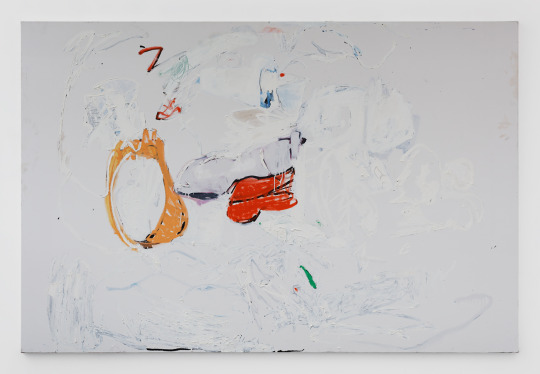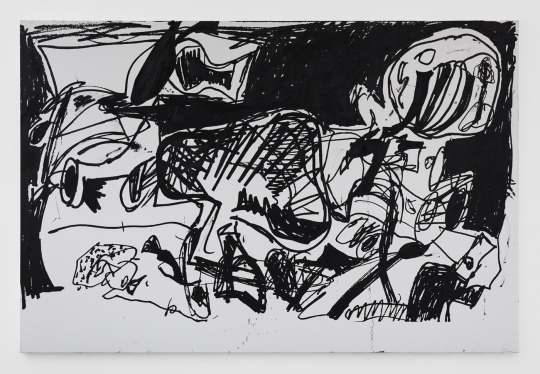
Bumper Traffic, Oil, acrylic, silkscreen ink and enamel on canvas 108 x 144 in. (274.3 x 365.8 cm)
An Interview with Visual Artist Eddie Martinez
Eddie Martinez’s recent exhibition Salmon Eye, at Mitchell-Innes & Nash, started out small. Martinez began each work as a sketchbook-sized drawing, little more than a doodle, which he would then blow up and print on massive canvases. After, he would paint on top of the drawing, riffing off of it, adding layers and colors that exaggerate or respond to the original. The resulting works combine the lightness and movement of a sketch with the monumental scale of a masterpiece.
A departure from the more shape-based, abstract compositions of his recent past, Salmon Eye signals Martinez’ return to representational imagery; many of the new paintings feel like vibrant, playful takes on the still life, the landscape, and even the portrait. These works synthesize unselfconscious abstraction with representational tropes to produce a pictorial language that is both formally skilled and childishly imaginative. They possess the immediacy of a dream or hallucination, raised to the level of the sublime.
Beyond the subtle touch and evocative mark-making evident in this exhibition, these paintings have dynamic outer structures, embedded in their line work, that echo in rhythmic webs, giving the chaos of these compositions a kind of mathematical internal harmony and proportion. The works include energetic splatters and deft calligraphy, the cascading freedom of chance operations balanced with Martinez’s incredibly articulate draftsmanship. It is a visual vocabulary of grandeur and grit.
I met with Martinez at Mitchell-Innes & Nash before a book signing in February of 2016. When he talked about his art, his eyes lit up. His enthusiasm for panting seemed, at times, like the well-worn familiarity of a master craftsman, and at others like the newfound excitement of a man discovering a favorite hobby. In the end, the quality that makes Martinez’s paintings uniquely and unmistakably his own is easy to recognize but almost impossible to define systematically—a distinctive touch, a dynamic energy, part restless and part epic. These paintings explode, but they also dance.
—Max Fierst
THE BELIEVER: What role does drawing have in your process?
EDDIE MARTINEZ: It’s almost outside of the process in a way because everything is about drawing, it always goes back to drawing. Drawing is the most immediate thing you can do anywhere. It’s like having a meditation practice, you can just take it with you wherever you go, wherever you are, no matter what. You can generally get a pen and a piece of paper or even like a barf bag on a plane.
BLVR: Right, you can bring paper with you or you can use a napkin.
EM: Yeah, exactly. And there’s the intimacy that comes with being able to do that. I feel like my brain must notice the space I’m in while I’m drawing and there are signals going, saying, “Oh, you’re relaxing on the couch watching TV.” Those drawings come out a little differently. Maybe they’re more free, maybe they’re more tense, depending on the situation.
Also I’m generally around other people when I’m drawing, and that doesn’t really happen in the studio when I’m painting anymore, you know? I don’t paint in a situation anymore where there are other energies that could influence what I’m doing. So how drawing comes directly into the process is that they get carried around with me, at home, in the painting studio, and they get stuff on them and then they become their own thing. But in this specific body of work, the paintings and drawings are related the most directly they’ve ever been related, in the sense that the drawings are being enlarged and put on canvases as a starting point for the painting. So more than ever it’s a very black-and-white kind of connection.
BLVR: What is the connection between drawing and experimentation? Do you like to experiment with drawing, because it’s not as much of a commitment as using paint? Or is drawing someplace where you feel more free to explore new ideas?
EM: I don’t know if it’s about separating the two and making it more free or not. It’s not like I didn’t draw when I started painting, and then I said, “Oh, I should draw.” I’ve always drawn.
BLVR: Drawing came first?
EM: Yeah, you know, as a kid, like anyone. Then I started skateboarding, so then I would draw the skateboard graphics. Then I would read Calvin and Hobbes so then I would draw Calvin and Hobbes, you know. [Pause] Drawing is primal. Yeah, it’s primal, and it’s my best friend, you know? It’s something that I can always have with me, that’s not gonna ruin me. Drawing is not a bottle of vodka.
BLVR: Obviously one difference between drawing on a sheet of paper and when you get to the scale of the paintings is that it becomes a much more athletic activity, right?
EM: I like that you said that.
BLVR: And actually, when you think about the fact that the drawings are on sheets of paper about an eighth of the size of you, and these paintings are twice as big as you are, or bigger, so it’s actually like, sixteen times human scale. I don’t know, my math is bad, but you know what I’m saying. If that was a drawing, the person who drew it would be a giant.
EM: Yeah, well that’s the exact idea I started with: make paintings that look like a giant’s drawings.

Lip Service, Oil and silkscreen ink on canvas, 72 x 108 in. (182.9 x 274.3 cm)
BLVR: So what is it like for you when you paint? Do you get very physical? Do you move around a lot?
EM: Definitely. I have actually hurt my body a lot over the last couple years while painting because of being kind of out of shape and not super limber. I should probably be in swimmer’s shape or something to actually work the way I want to work [Laughs]. But I make do. But yeah it’s all about speed and being up close and making marks and moves and picking colors, not even looking at what they are all the time, just getting them on as soon as possible. That’s where the practice of drawing comes into play, when you’re making big quick moves but as casually as if you were jotting down a grocery list, something natural and effortless.
BLVR: Is working that way to prevent them from being—?
EM: Too controlled?
BLVR: Do you feel like emotion flows more freely or naturally than if you were more controlled in your approach?
EM: It’s like doing a blind contour line drawing. Remember having to do that?
BLVR: Yeah!
EM: So, it’s like that, that’s what I want the studio to feel like.
BLVR: So that your mental and physical forces are working in unison?
EM: Yeah, exactly.
BLVR: It’s improvisation?
EM: Yeah, it’s improvisational, and for example I could just sit here and like, hear that conversation in the distance and [pause] it does something to me, so maybe I’ll be like, trying to hear it less, so I’ll move to this part of the page or something, away from it.
BLVR: Mm-hmm.
EM: You know? [Laughs] But that’s the best thing about drawing, is the element of surprise. That’s one of the things I really like about it.
BLVR: That you yourself are getting to be surprised by your drawings?
EM: Yeah, and so quickly. I’ve always been such a fiend for immediate gratification, and satisfaction. I mean, I’m calming down now that I’m getting older, but drawing always will still give me that feeling of being a kid and buying a new GI Joe guy. Feeling, like snatching a new toy off the shelf and ripping it open, you know? The thrill you get from that, that’s what drawing’s like.
BLVR: That’s so great that you said buying a GI Joe guy, because for me as a child, that was the ultimate treat, to be taken to Toys R Us and buying a GI Joe.
EM: That was it. On a Saturday, when your grandma was in town or something, and you go get a GI Joe, and the whole day you’re anticipating and then when you get it, you rip it open!
BLVR: Yeah!
EM: So, yeah, especially sometimes, I’m like “Fuck! I’m lucky I made that drawing!” And I could’ve sat down and first made fifteen drawings that I ripped up immediately. But then that one pops out.
BLVR: So that’s the other part of your process? That you edit your output very heavily? You produce a lot, and then you take the cream of the crop for paintings?
EM: Especially now, yeah. More so than the past. A lot of people, I think, showed when they were younger and had someone in their ears telling them don’t put out too much, don’t yadda yadda, but I kind of figured it out on my own. And now a painting doesn’t leave the studio unless it’s a painting I would have in my house. But it took me a long time, to get that discipline, you know?

Air-Lechinsky, Oil and silkscreen ink on canvas, 72 x 108 in. (182.9 x 274.3 cm)




